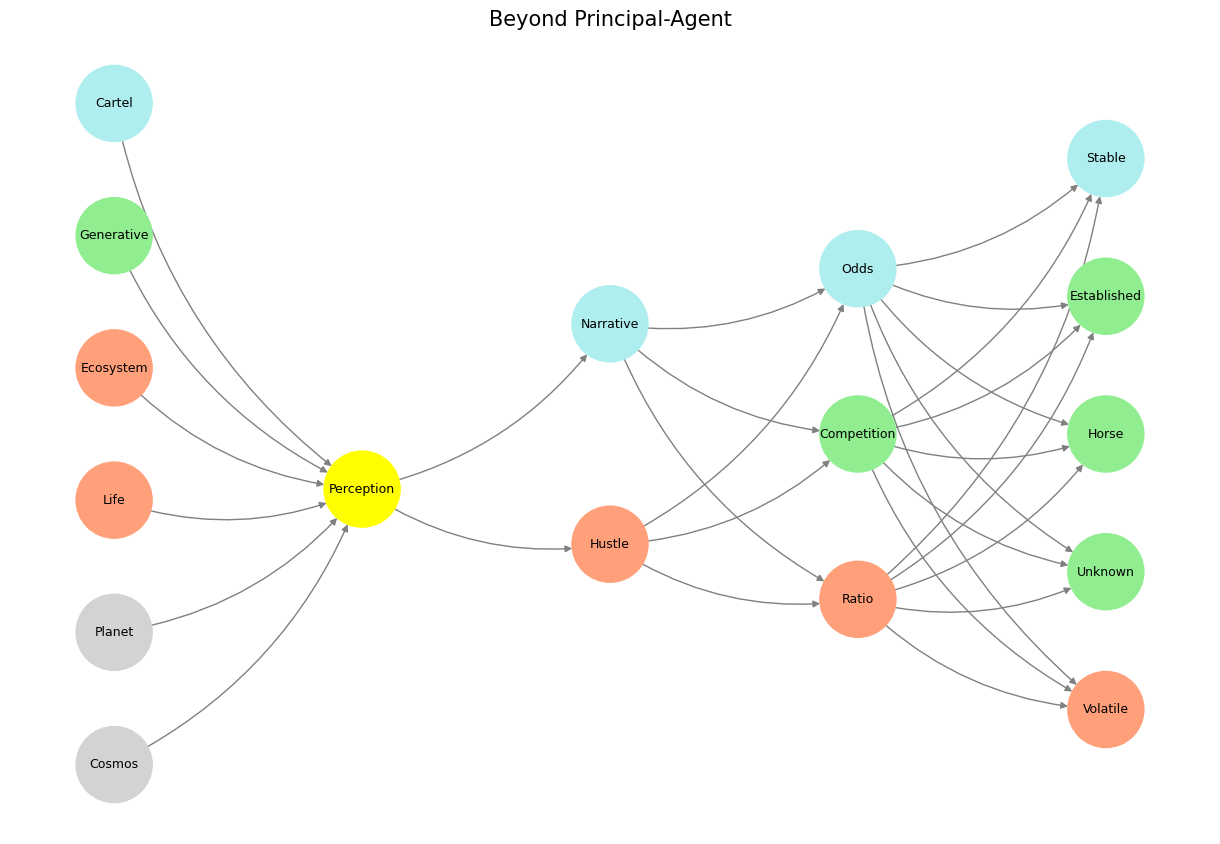Attribute#
The principal-agent problem, foundational in economic and sociological analysis, has long been simplified into a binary dilemma: the principal, whose interests need serving, and the agent, whose actions can drift away from these interests. This duality often collapses a richer web of dynamics into a lazy, overly simplistic frame. Even the addition of a “third category,” such as an undefined “other,” only marginally acknowledges the depth and nuance of real-world systems. To breathe life into this abstraction, we need to explode the binary, reject “othering” as a superficial patch, and examine the fractal dimensions underlying these relationships.
From Binary to Network Dynamics#
The binary itself is not inherently wrong—it is simply incomplete, a low-resolution snapshot of a high-resolution fractal system. In a fractal neural network, categories such as principal, agent, and “other” are nodes in a dynamic graph, layered and recursively interacting. This network evolves across multiple axes, from the cosmic to the microscopic, where perception, agency, and physical dynamics emerge as essential layers in this multidimensional schema.
Each layer unfolds its complexity:
World Layer (Cosmos, Planet): The macrocosm, encompassing cosmos, ecosystems, and the interplay of generative and cartel-like structures, serves as the scaffolding. Principals and agents here are forces—economic, natural, or ideological—jockeying for position within a shared, yet contested, system.
Perception Layer (Life): Anchoring cognition, perception becomes a single node, yet it drives everything. What we see defines the architecture we build, biases we embed, and dynamics we set into motion.
Agency Layer (Ecosystem): Far from being reducible to “principal” and “agent,” this layer includes hustle and narrative—metaphors for the actions and meanings humans assign to their roles. Hustle encapsulates effort and iteration, while narrative reflects the symbolic framing that governs these actions.
Generative Layer (Street, Public Square, Creativity): This is where odds, competition, and ratio interplay. It models not just relationships but the emergent properties of interaction—risk, reward, and iteration.
Physical Layer (Cartels, Jostling, Freedom): Incorporating the volatile and stable, the known and unknown, this layer captures the system’s grounding in tangible reality. It’s the feedback loop that binds abstraction to material conditions.
Beyond “Principal-Agent-Other”: A Living Fractal#
The concept of adding a third category such as “other” often serves as a lazy middle ground, a catch-all for undefined complexities. This “next-level laziness” acknowledges the insufficiency of the binary but refuses to confront its deeper inadequacies. A fractal neural network challenges this tendency by embracing the recursive nature of interactions, where each node is both a cause and consequence of the network’s evolution.
This approach incorporates:
Recursive Layers: Layers like “Generative” and “Agency” are not static but recursive, influencing and being influenced by the layers above and below them. Odds and competition within the generative layer, for example, loop back to influence perception and agency.
Feedback Mechanisms: Feedback in this network mirrors the acetylcholine-mediated resilience of human neural systems. Stable nodes reinforce equilibrium, while volatile nodes trigger adaptation, creating an evolutionary dynamic.
Dynamic Color Coding: The use of colors like paleturquoise (stability and order) and lightsalmon (volatility and sacrifice) is not aesthetic but functional, encoding the system’s emotional and structural dynamics.
Generating Insights with Network Visualization#
The code provided mirrors this philosophy by constructing and visualizing a layered graph. The network draws its beauty not from static clarity but from its dynamic potential:
Nodes are contextual yet interdependent.
Layers form conduits for information flow.
Recursive edges model the circularity of influence.
By visualizing these dynamics, we move beyond the static simplicity of the principal-agent binary into a living system that captures the essence of interaction: iterative, volatile, and generative.
A Call to Action: Reweighting for Richer Understanding#
This essay invites us to reject simplistic dichotomies and instead build models that reflect the vibrant complexity of human and systemic interactions. By integrating principles of network dynamics, feedback loops, and recursive interactions, we uncover a richer understanding of systems—one that evolves, adapts, and generates insights.
In the fractal neural network of thought, no node exists in isolation. The principal-agent binary collapses; the “other” dissolves into context. What emerges is not just a network but a living system—a cosmos alive with possibility.
Show code cell source
import numpy as np
import matplotlib.pyplot as plt
import networkx as nx
# Define the neural network fractal
def define_layers():
return {
'World': ['Cosmos', 'Planet', 'Life', 'Ecosystem', 'Generative', 'Cartel', ], ## Cosmos, Planet
'Perception': ['Perception'], # Life
'Agency': ['Hustle', 'Narrative'], # Ecosystem (Beyond Principal-Agent-Other)
'Generative': ['Ratio', 'Competition', 'Odds'], # Generative
'Physical': ['Volatile', 'Unknown', 'Horse', 'Established', 'Stable'] # Physical
}
# Assign colors to nodes
def assign_colors():
color_map = {
'yellow': ['Perception'],
'paleturquoise': ['Cartel', 'Narrative', 'Odds', 'Stable'],
'lightgreen': ['Generative', 'Competition', 'Established', 'Horse', 'Unknown'],
'lightsalmon': [
'Life', 'Ecosystem', 'Hustle', # Ecosystem = Red Queen = Prometheus = Sacrifice
'Ratio', 'Volatile'
],
}
return {node: color for color, nodes in color_map.items() for node in nodes}
# Calculate positions for nodes
def calculate_positions(layer, x_offset):
y_positions = np.linspace(-len(layer) / 2, len(layer) / 2, len(layer))
return [(x_offset, y) for y in y_positions]
# Create and visualize the neural network graph
def visualize_nn():
layers = define_layers()
colors = assign_colors()
G = nx.DiGraph()
pos = {}
node_colors = []
# Add nodes and assign positions
for i, (layer_name, nodes) in enumerate(layers.items()):
positions = calculate_positions(nodes, x_offset=i * 2)
for node, position in zip(nodes, positions):
G.add_node(node, layer=layer_name)
pos[node] = position
node_colors.append(colors.get(node, 'lightgray')) # Default color fallback
# Add edges (automated for consecutive layers)
layer_names = list(layers.keys())
for i in range(len(layer_names) - 1):
source_layer, target_layer = layer_names[i], layer_names[i + 1]
for source in layers[source_layer]:
for target in layers[target_layer]:
G.add_edge(source, target)
# Draw the graph
plt.figure(figsize=(12, 8))
nx.draw(
G, pos, with_labels=True, node_color=node_colors, edge_color='gray',
node_size=3000, font_size=9, connectionstyle="arc3,rad=0.2"
)
plt.title("Beyond Principal-Agent", fontsize=15)
plt.show()
# Run the visualization
visualize_nn()


Fig. 29 Glenn Gould and Leonard Bernstein famously disagreed over the tempo and interpretation of Brahms’ First Piano Concerto during a 1962 New York Philharmonic concert, where Bernstein, conducting, publicly distanced himself from Gould’s significantly slower-paced interpretation before the performance began, expressing his disagreement with the unconventional approach while still allowing Gould to perform it as planned; this event is considered one of the most controversial moments in classical music history.#

